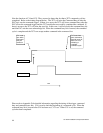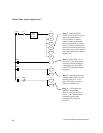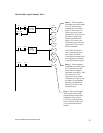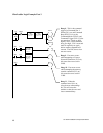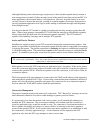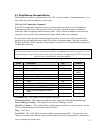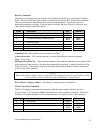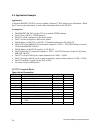
CTI 2572 Installation and Operation Guide
50
Although buffering ensures that messages are preserved, it does introduce update latency because a
new message must wait until all other messages stored in the module have been read by the PLC. For
many applications, the increased latency is not significant. However, if update latency is an issue,
you may choose to increase the data size, resulting in a smaller number of messages in the queue or
you may implement application-level logic to defer sending an additional message until the partner
acknowledged receipt.
You may note that the 2572 module is capable of sending and receiving messages greater than 560
bytes. When a large message is transmitted, TCP will break the message up into multiple segments,
each no larger then 560 bytes and will transmit each segment separately. The 2572 module is
capable of reassembling a message sent in multiple TCP segments.
Active and Passive Partners
Send/Receive requires a point-to-point TCP connection between the communications partners. One
partner is responsible for initiating the connection request while the other is responsible for accepting
or rejecting the request. The partner responsible for initiating the request to establish the connection
is called the Active partner. The partner that responds to the connection request is called the Passive
partner. To establish a peer-to-peer connection one partner must be Active and the other Passive.
NOTE:
The connection is full duplex. Once the connection has been established, both partners may use the
connection to send and receive data.
Either partner can close the TCP connection (via application logic), if required. If the Active partner
closes the connection, the Passive partner will return to the state in which it is listening for request to
connect at the specified TSAP. If the Passive partner closes the connection, it will cease to listen for
a connection request.
The Passive partner will reject attempts to connect unless the TSAP and IP address of the requesting
node match those specified in PLC logic. If an existing connection has been established, the Passive
partner will close the existing connection and open a new connection if a new connection request is
received where the TSAP and IP address match the specifications.
Connection Management
The protocol manager monitors the status of all connections. TCP “KeepAlive” messages are used to
detect abnormal connection loss such as cable breakage or partner processor failure.
If a connection is lost when the module is the Active partner, it will automatically attempt to re-
establish the TCP connection. The re-connection attempts will continue until the connection is
closed by application logic or until the module is reset. If a connection is lost when the module is a
Passive partner, the module will return to a state in which it is listening for the Active partner to
connect at the specified TSAP. It will remain in this state until a connection is re-established or until
the connection is closed by application logic. A lost connection will be reported to the PLC
application only when the PLC logic attempts to send or receive data.





